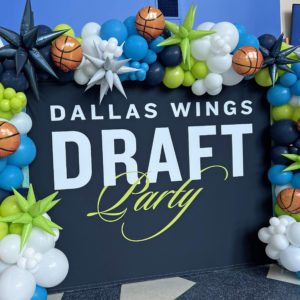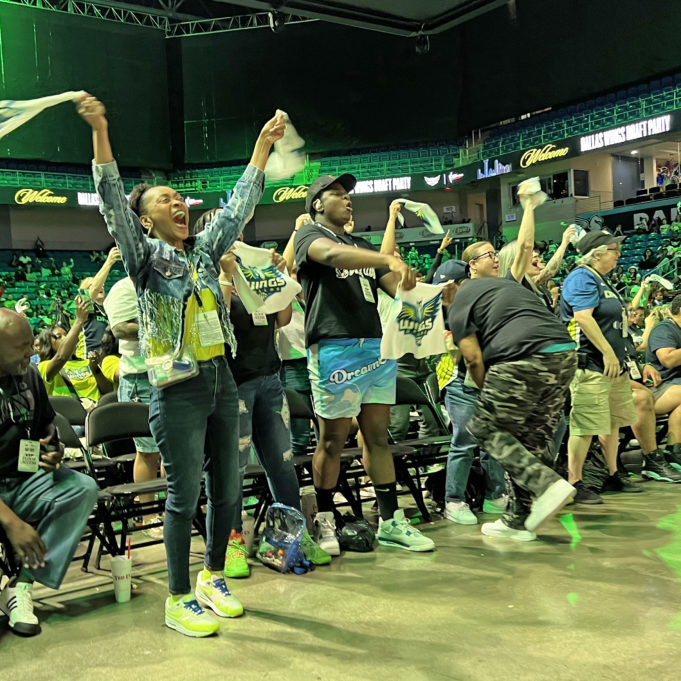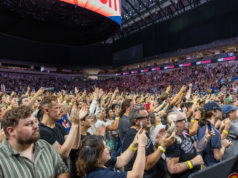Monday night, the Dallas Wings, who currently play their home games in Arlington, Texas, controlled the first selection in the WNBA’s annual draft of college and international players. They chose UConn star Paige Bueckers.
Amazingly, Bueckers, the top pick of the best women’s basketball league in the world, also reportedly signed a contract with an entirely different hoops league the week prior. So you might be thinking: “Could this turn out like it did the first time Tarrant County featured prominently in the first overall selection in a pro basketball draft?”
Actually you’re probably not thinking that because it happened in 1947 when pro basketball for any gender was barely a thing. The Basketball Association of America, conducting a joint draft with the National Basketball League (prior to their merger that resulted in what we now know as the National Basketball Association), saw its Pittsburgh Ironmen take Clifton McNeely number one overall. McNeely, a World War II vet, had starred at Fort Worth’s Texas Wesleyan College (now University). McNeely, however, never suited up for the Ironmen, and not just because the franchise folded before the season began. The prolific scorer decided to go into high school coaching and never played at all professionally.
We don’t actually need to worry about this latest top pick not joining the team that chose her. In fact, Bueckers said she was “excited to start that new chapter and be in a new city and explore that and give everything I have to the Wings organization.” The other league with whom she is now affiliated, Unrivaled, stages three-on-three games during the WNBA offseason.
So while she’ll play pro basketball after all, her choice to do so in two leagues resembles the one McNeely made in a key respect: it has to do with making a living. In the 1940s, coaching at Pampa High School paid at least comparably to, and almost certainly more consistently than, fledgeling pro hoops. Bueckers will make $78,831 in salary from the WNBA in 2025. While that’s not a bad starting salary for many young people fresh out of college, she’ll make a good bit more playing for Unrivaled.
One reason teams in both circuits want the former UConn Husky on their courts has to do with the way she plays the game.
 “She’s just so unselfish,” said her future Wings head coach, Chris Koclanes. “She can take over a game when she wants to and when she needs to but she just has such great feel for getting others involved, and that’s something that’s really special.”.
“She’s just so unselfish,” said her future Wings head coach, Chris Koclanes. “She can take over a game when she wants to and when she needs to but she just has such great feel for getting others involved, and that’s something that’s really special.”.
In fact, Bueckers has a reputation of being supportive of her college teammates, many of whom joined her in New York to watch her big moment Monday. Basketball has always been a team game, with a competitor’s willingness to make the extra pass or help on defense deservedly lauded. It’s that way off the court in many ways, too, as the sport of women’s basketball itself looks to maximize progress across the board.
“As someone that’s been in the game 35 years, I’ve always been very bullish that our product is outstanding,” said Wings Executive VP for Basketball Operations and General Manager Curt Miller. “Now we have more fandom. We have more eyes on our game than ever, and our product’s always been tremendous. We just needed a spark to get more eyes on our game, and we have it now, and so it’s a really, really exciting time for women’s basketball.”
Miller didn’t mind his star playing in a league that isn’t his. In part that attitude stems from the way player offseasons worked for most of the WNBA’s history.
“I’m excited for her to not have to go overseas, excited for our entire league, and especially our top players, to be able to stay over here and play in another league,” he said. “For as long as I can remember, we’ve chased contracts overseas.”
In the past, women’s pro players took the court virtually year-round, as they would play in the WNBA during the summer and other countries’ leagues during the fall, winter and spring. Competing with minimal breaks could take a physical and mental toll, but some European and Asian teams paid significantly higher salaries than the W. Unrivaled plays its season entirely in the U.S., as does a winter five-on-five league called Athletes Unlimited. Both of those alternative leagues offer equity stakes to their players, too. Sometimes the high remuneration offered in leagues abroad was often based on the desire of wealthy team owners to win than on a salary structure that was part of a profitable business plan. Unrivaled, having apparently taken in more revenue than expected in its first year, might be able to justify its sizable payouts as part of a sustainable structure. These all provide options for players, and they can still choose to play in Europe or Asia if they want to.
There’s a teamwork aspect to this. All of those leagues are nationally televised and, as Miller noted, create visibility for the game. While they don’t directly support each other, they showcase talented athletes in the sport and generate interest that benefits all (as does the NCAA game from which most of Monday’s draft picks emerged). The WNBA’s lower salaries have, in part, been a result of the need to try to make sure at least one league in the U.S. survived. New larger TV contracts for the W will affect the next labor agreement and may result in more substantial compensation for players. Women’s pro sports in general have been on the rise.
 Taking advantage of the buzz around their anticipated top pick, the Wings held a draft-night party for fans at Arlington’s College Park Center. Before the selections commenced, performers entertained the fans and they also did some trivia with fans. The host’s first question asked the Wings’ opponent for the team’s regular-season opening game. The fan correctly identified the Minnesota Lynx as the foe for that May 16th home contest. One could also take note that one of the incorrect multiple choice responses was a cheeky feint: the Sacramento Monarchs. The Monarchs were one of the WNBA’s original franchises when it began play in 1997, but they ceased operations in 2009. Other teams have folded or moved in the league’s history, including two in Texas. That’s the nature of startup leagues, as the example of the 1947 Pittsburgh Ironmen illustrates.
Taking advantage of the buzz around their anticipated top pick, the Wings held a draft-night party for fans at Arlington’s College Park Center. Before the selections commenced, performers entertained the fans and they also did some trivia with fans. The host’s first question asked the Wings’ opponent for the team’s regular-season opening game. The fan correctly identified the Minnesota Lynx as the foe for that May 16th home contest. One could also take note that one of the incorrect multiple choice responses was a cheeky feint: the Sacramento Monarchs. The Monarchs were one of the WNBA’s original franchises when it began play in 1997, but they ceased operations in 2009. Other teams have folded or moved in the league’s history, including two in Texas. That’s the nature of startup leagues, as the example of the 1947 Pittsburgh Ironmen illustrates.
In 2025, though, the new Golden State Valkyries participated in their first draft and more WNBA expansion is on the horizon. That will mean more opportunities for women to make money playing their sport. That’s the trajectory the men’s game took as people discovered its value through players like Russell, Baylor, West, Chamberlain, Erving, Bird, Jordan, and more. The Paige Bueckers of the world seem to have the women’s game headed that direction as well.












